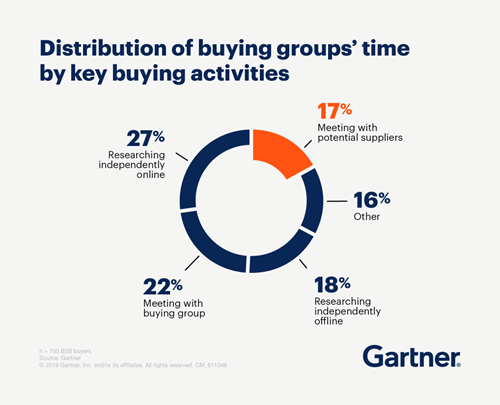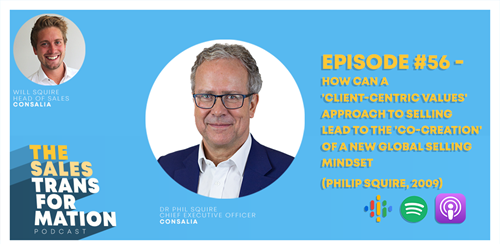“It’s not just about the customer, it’s their entire ecosystem, including partners, suppliers, customers and competitors. Client-centricity requires curiosity, interest and passion to do the right thing for the client, going the extra mile to find out more, leveraging more value for the customer, and demonstrating non-autobiographical listening skills. It’s consistently searching for new knowledge of the customer’s business and looking for ways to add value to their business” – Selling Transformed, Phil Squire, CEO, Consalia.
In the sales industry, to truly be successful and part of the top 10% of salespeople, an individual must have more than just the right skills and knowledge. It's also about having the right mindset. This in combination with the right skills and knowledge is what sets great sales leaders apart from others. In this blog, we will discuss the importance of client-centricity and the 2 essential tools salespeople should have in order to be successful: having the ability to “crack the code” and “pulse check”.
Client-centricity is being all about the customer. This requires such things as knowledge, passion, interest, being dedicated and going the extra mile. Salespeople will display non-autobiographical listening skills and constant curiosity, with the client’s best interest in mind. Client-centricity is a key sales mindset.
Before we dive into the 2 tools salespeople need to be successful, let’s first restate the other key sales mindsets salespeople must have, outside of client-centricity:
- Authenticity – Being honest, credible, unpretentious, sincere, ethical, and dependable. Authenticity also means being original. This in combination with the other attributes will allow salespeople to not only be themselves but also allow space for creating original ideas. Most importantly, this value lets the client see the salesperson as being trustworthy – as in not method acting.
- Proactive creativity – This requires a more strategic way of thinking. It’s being a forward-thinker, innovative, creative, reflective and going above and beyond. It’s coming up with ideas the customer may not have thought of before and being two steps ahead. It also means using subject-matter experts where they see they lack key knowledge from both inside and outside their organisation.
- Tactful audacity – One of the more difficult values to master; knowing where the line is and how far to go without going too far. This value is very difficult if the client and salesperson have not established a relationship. But having tact, or having emotional intelligence, being daring, bold, challenging, aware of limits, diplomatic, unconventional and enthusiastic will lead a salesperson to the top 10% of salespeople.
Although all 4 mindsets are equally important, client-centricity is key to building a better understanding of your clients. This will help in prioritising the customer’s needs and providing solutions that meet their specific requirements. B2B sales organisations will be able to build and nurture strong and lasting relationships with their customers. This could also lead to the increased credibility of the company's portfolio when approaching future clients.
Who are today’s customers?
Today’s customers are much more knowledgeable about the sales process than in the past. According to research by Gartner, salespeople have less control of the narrative regarding sales deals, because customers are doing their own research, and are spending less time with suppliers. It seems that digital avenues have made it easier for customers to gather information on their own.

They have become more discerning and demanding, and they expect sales organisations to understand their needs and provide solutions that meet those needs exactly. Essentially, the customer comes first, and they know it. By putting the customer first, and incorporating the values attached to being client-centric, salespeople and their organisations are not only more likely to make a sale, but also stand out from the endless sea of B2B organisations.
Read this case study on how Allied Mining used client-centricity to win a major account.
Knowing your customer is not enough: crack the code
Dr Philip Squire, CEO, Consalia, spoke in detail about his history working with two leading professors at IMD. In his book Selling Transformed, he mentions how both professors, who are specialists in global account management, shared the opinion that for a salesperson to simply know their customers and their customers, is simply not enough. It is also very important to have a full understanding of the industry the customer is operating in and the events happening in it.
For example, knowing the critical factors that drive profitability in, perhaps the automobile sector would help sales teams selling into that sector. The flooding in Thailand caused factories as far away as Kentucky to close temporarily to conserve parts. There is so much economic interdependence globally. Whilst driving down the cost of production by setting up factories in different countries could lower costs, it could also increase risk. The Covid-19 pandemic vividly demonstrates the risk associated with interdependence of key elements of the supply chain. Just having this level of industry knowledge can help generate those priceless insights that may lead to making significant contributions to winning value propositions.
Once a salesperson has a full understanding of their customer’s industry, then they can understand how to bring value to their client and how they can stand out. This leads us to the first tool client-centric salespeople embody: ‘cracking the industry code’.
The industry code is the behaviour required from an organisation to assure long-term success. It must be met to achieve profitability and success. Violating this code would endanger a business’s profitability.
To crack the code, companies must know:
- What are the segments the customer must be part of to be seen as a major player?
- What are the combinations or bundles of segments the customer must be part of? This is important as they must know what segments are best for them, hence why they must be part of a few in order to determine this.
- What is the minimum about of marketing needed?
- What is the minimum size requirement to be considered competitive or successful?
- What is the required level of integrity? This is important to understand how it may affect profitability.
- Identify the focus and/or restrictions
- What are the strategic dilemmas the company is facing?
- What are the major dilemmas the industry is facing?

Keep your finger on the pulse
To be client-centric, salespeople should also do a ‘pulse check’. This is a list of questions that will better help salespeople understand their clients, but also test how well they already know them. In the sales industry, it is not uncommon for situations to change abruptly. If the relationship between salesperson and client is well established and there is a full understanding of the client, their situation, goal and industry, abrupt change will be easier to manage.
The things to consider, and questions you should ask yourself when testing how well you know your customer include:
Driving performance and transformation – under this category some important questions might be:
- What is your customer’s current financial situation? What do their balance sheet and income statements reveal? What is your customer’s cost structure and cash flow?
- Is your customer financially/fiscally “healthy”?
- What does your customer think would improve their financial position?
- What are the sticking points or challenges with their financials?
- What are your customer’s long-term financial goals? Where do they want to be in a year? Three years? Five Years?
- What are your customer’s business and individual performance metrics?
- What is their source of competitive advantage?
- How has your customer been performing for the past three years?
- What are the metrics for the next three years and how do they plan to achieve them?
- What would help your customer to increase performance against these metrics?
- How will your offer help your customer meet and exceed their financial objectives?
- How will your offer help your customer to reach their near, mid, and long-term strategic goals?
Stakeholder perception of the customer:
- How do customers (end-users) talk about your customer?
- What type of company is your customer perceived to be?
- How does your customer want to change these perceptions?
- Why do end-users switch to one of your customer’s competitors?
- Why do end-users remain with your customer?
- What attracts new end-users to your customer?
- Who is your customer’s end-user? (demographics, psychographics)
- Who are the “hot” end-users? Today? Tomorrow? Why?
- How is the end-user changing?
- How much does your customer spend on customer acquisition?
- How does your customer listen to their customers to obtain actionable information?
- How will your offer improve your customer’s ability to improve the way they interact with their customers?
Leadership strategy and constancy of purpose:
- What is their purpose?
- What are their stated values? How committed are they to their values?
- How has this changed?
- What are your customer’s strengths and weaknesses in creating the future?
- What is “success” for your customer? What is driving this definition?
- How does your customer plan to achieve this success? What would help them?
- With what does your customer feel comfortable and what are their concerns?
- What change initiatives are going well and what are not going well for your customer?
- What are the C level Key Performance Indicators
- How will your offer improve the way support the organisation’s purpose?
- How will your values align with the customer’s values
Strategic operational performance:
- How does the customer seek to increase operational efficiencies.
- How does the customer seek to reduce operational costs and to what degree?
- What are the key metrics to measure operational performance?
- How does the customer’s supply chain flow?
- What and where are the customer’s critical supply chain challenges and vulnerabilities?
- What is the customer doing to improve supply chain performance?
- What systems and technology does the customer use to enable their operations and supply chain? What is their online strategy?
- How does your customer ensure that their suppliers are qualified and positioned to enhance performance and increase customer satisfaction?
- How does your customer evaluate supplier performance?
- What is the customer’s situation with suppliers – e.g., is the market dominated by a few large suppliers, are there many suppliers or is there one key supplier on which they depend?
- Can the customer be flexible with suppliers or are they constricted by high switching costs?
- How will your offer improve your customer’s processes to reduce cost or increase revenue or margin?
Organisational culture and leadership:
- How is your customer organised to achieve and sustain their vision?
- What capabilities and competencies do they need to develop to implement their strategy?
- How does your customer recruit, hire, place, and retain new members of their workforce?
- How does your customer manage and evaluate organisation and people performance?
- How does your customer prepare their workforce for changing capability and capacity needs?
- How does your customer develop a high-performance organisational culture?
- What commitment do they have to continuous learning?
- What is their organisational culture?
- How empowered are employees?
- What do ex-employees say about your customer?
- How in tune with their strategy is their culture?
- How will your offer impact on the customer’s employees?
- How will your offer impact the decision-makers’ reputation?
- How will your offer impact their culture?
Stakeholder engagement:
- What ecosystem does your customer rely on to compete?
- What is their partner strategy? Who are their key stakeholders?
- What percent of the customer’s income comes from channel partners?
- How important are partners to your customer?
- How do they segment their partners?
- What support do they provide their partners?
- What is the risk in their partner channel?
- What other associations or public bodies are they connected with?
- What entry/exit constraints exist for these segments?
- How does your customer plan to retain their partners, and acquire new end-users and markets?
- What political influences do they have?
- How can your offer or your organisation impact their stakeholders?
Creating sustainable value:
- What is your customer’s corporate social responsibility strategy or CSR?
- What environmental policies do they have? How committed are they to achieving these?
- What goals and targets do they have in achieving their CSR strategy? To what extent are these being reached?
- What are their diversity targets?
- How can your company’s products, services, and support help your customer to enhance their brand position with these end-users and in these markets?
- How is the customer’s brand perceived?
Once again, in the B2B sales process, customer-centricity is one of the 4 fundamental values an excellent salesperson should have. It refers to a focus on understanding the needs and motivations of the customer and using that understanding to drive the sales process. By understanding the customer's needs, situation and goals, the salesperson can provide tailored solutions. Client-centricity will also lead to a stronger relationship and ultimately, increased sales.

Gain a deeper knowledge of the benefits of having a client-centric value approach to selling, by listening to Episode 56 of the Sales Transformation Podcast: “How can a 'client-centric values' approach to selling lead to the 'co-creation' of a new global selling mindset (Philip Squire, 2009)”
